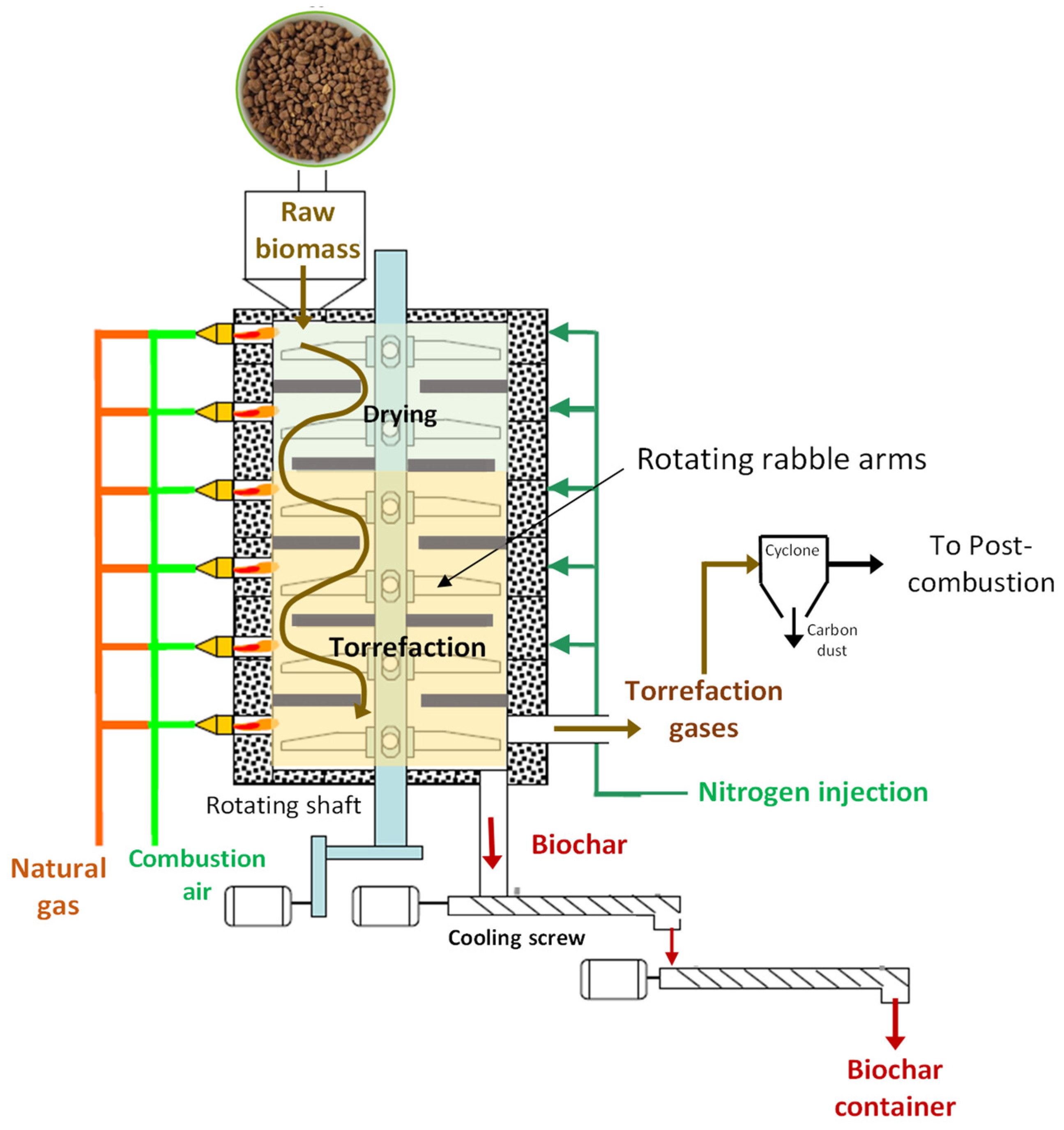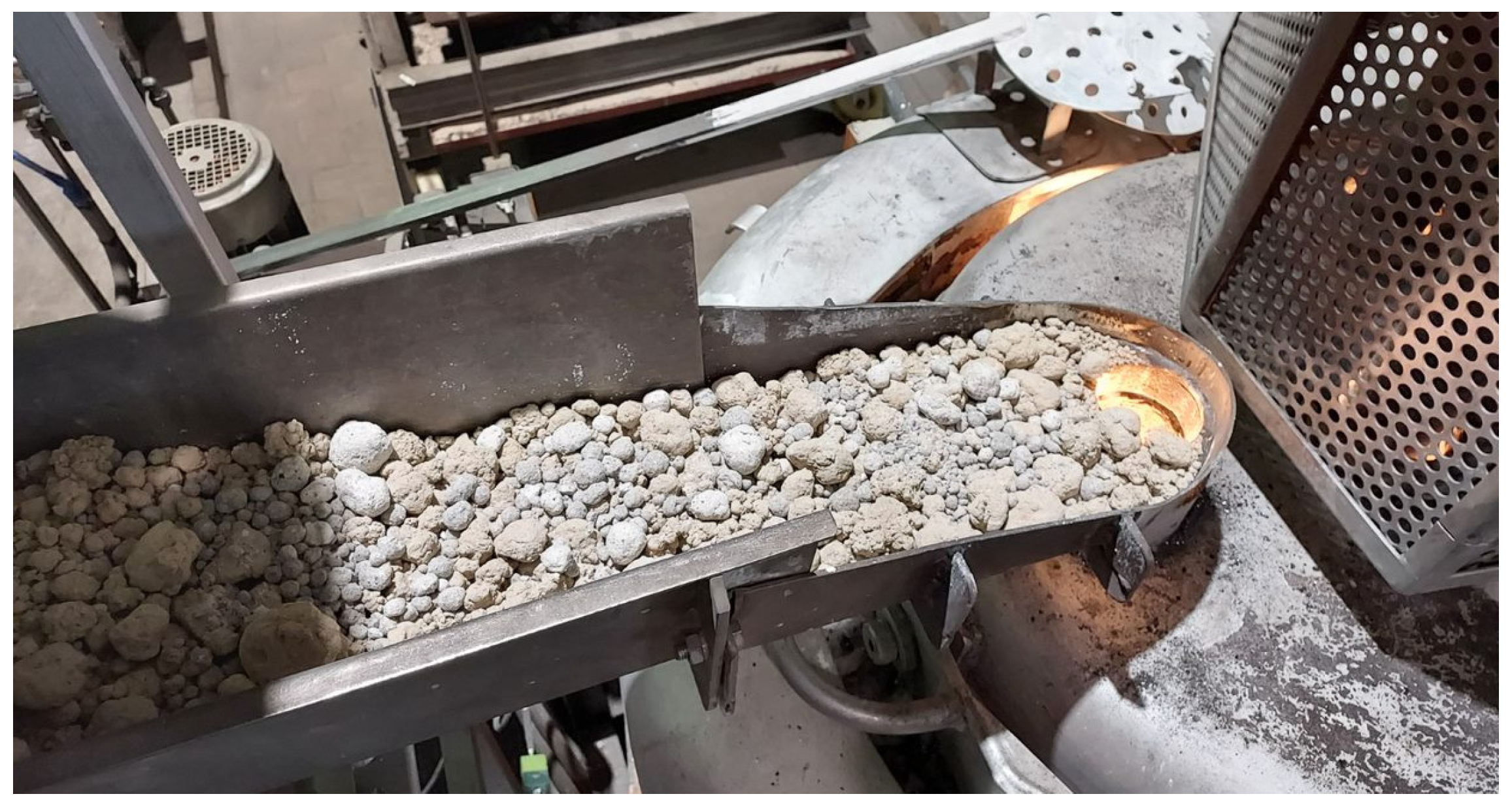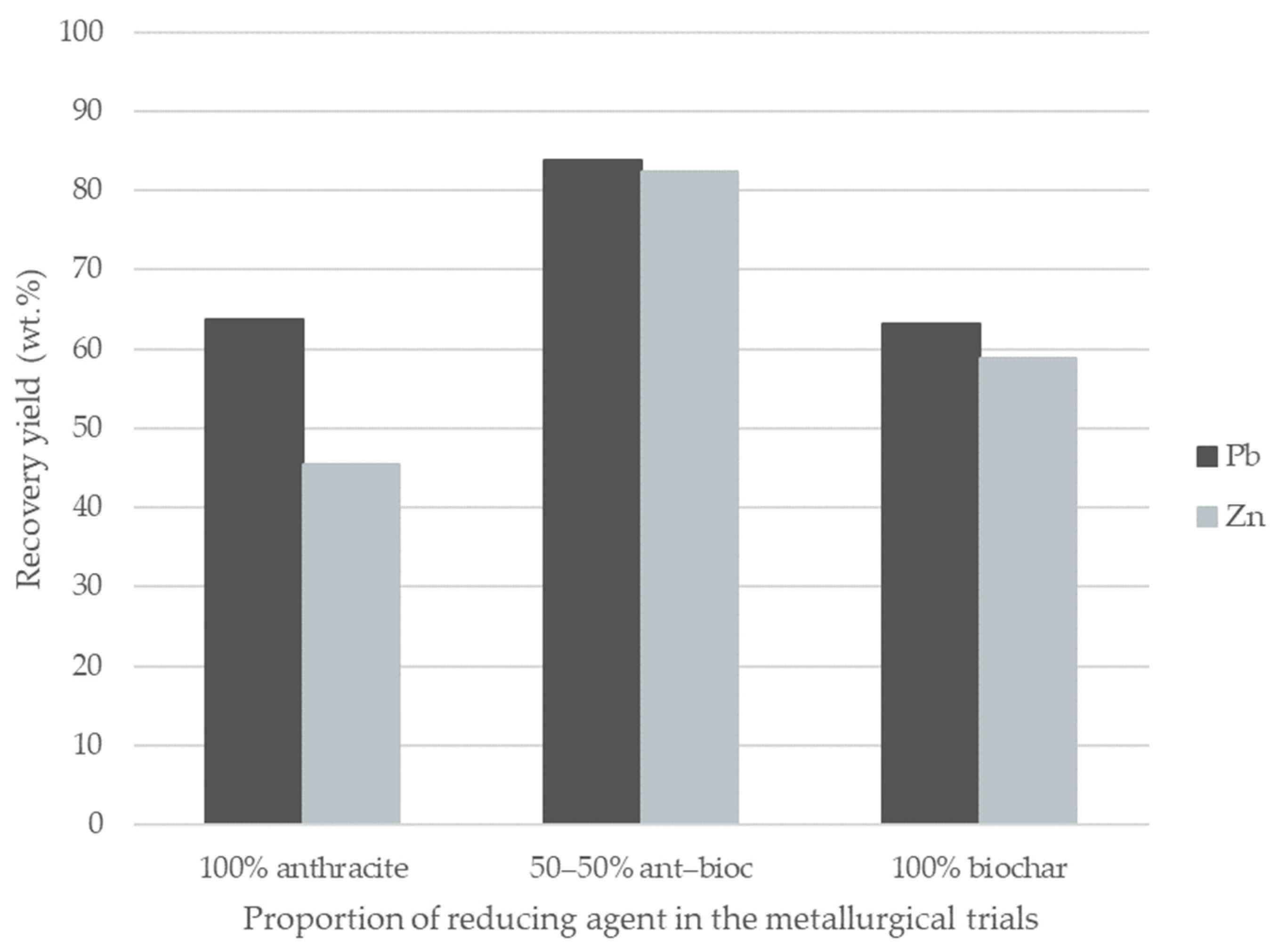Development of a Sustainable Metallurgical Process to Valorize Copper Smelting Wastes with Olive Stones-Based Biochar
Abstract
1. Introduction
2. Materials and Methods
2.1. Raw Materials
2.1.1. Waste
2.1.2. Biochar
2.1.3. Anthracite
2.1.4. Bentonite
2.2. Preparation of Pellets
2.3. Metallurgical Trials
2.4. Characterization of the Materials
2.4.1. Proximate and Ultimate Analyses
2.4.2. Calorimetric Analysis
2.4.3. Chemical Analysis
2.4.4. X-ray Diffraction
2.4.5. Scanning Electron Microscope
3. Results and Discussion
3.1. Characterization of the Raw Materials
3.1.1. Characterization of Waste
3.1.2. Characterization of Reducing Agents
3.2. Characterization of the Process Streams
3.2.1. Filter Dusts Recovery Yields
4. Conclusions
Author Contributions
Funding

Acknowledgments
Conflicts of Interest
References
- Montenegro, V.; Sano, H.; Fujisawa, T. Recirculation of high arsenic content copper smelting dust to smelting and converting processes. Miner. Eng. 2013, 49, 184–189. [Google Scholar] [CrossRef]
- Morales, A.; Cruells, M.; Roca, A.; Bergó, R. Treatment of copper flash smelter flue dusts for copper and zinc extraction and arsenic stabilization. Hydrometallurgy 2010, 105, 148–154. [Google Scholar] [CrossRef]
- Ríos, G.; Ruiz, I.; Rius, O.; Cruells, M.; Roca, A. Leaching of copper from a flash furnace dust using sulfuric acid. Miner. Process. Extr. Met. Rev. 2021, 43, 411–421. [Google Scholar] [CrossRef]
- Martín, M.I.; López-Delgado, A.; López, F.A.; Coedo, A.G.; Dorado, M.T.; Alguacil, F.J. Treatment of Copper Converter Flue Dust for the Separation of Metallic/Non-metallic Copper by Hydrometallurgical Processing. J. Chem. Eng. Jpn. 2003, 36, 1498–1502. [Google Scholar] [CrossRef]
- Chen, Y.; Liao, T.; Li, G.; Chen, B.; Shi, X. Recovery of bismuth and arsenic from copper smelter flue dusts after copper and zinc extraction. Miner. Eng. 2012, 39, 23–28. [Google Scholar] [CrossRef]
- Alguacil, F.J.; Garcia-Diaz, I.; Lopez, F.; Rodriguez, O. Recycling of copper flue dust via leaching-solvent extraction processing. Desalin. Water Treat. 2012, 56, 1202–1207. [Google Scholar] [CrossRef]
- Ha, T.K.; Kwon, B.H.; Park, K.S.; Mohapatra, D. Selective leaching and recovery of bismuth as Bi2O3 from copper smelter converter dust. Sep. Purif. Technol. 2015, 142, 116–122. [Google Scholar] [CrossRef]
- Cui, W.; Chen, M.; Zhao, B. Pyrometallurgical Recovery of Valuable Metals from Flue Dusts of Copper Smelter Through Lead Alloy. In Proceedings of the 9th International Symposium on Lead and Zinc Processing, San Diego, CA, USA, 23–27 February 2020; pp. 539–547. [Google Scholar]
- Gorai, B.; Jana, R.K.; Khan, Z.H. Electrorefining Electrolyte from Copper Plant Dust. Mater. Trans. 2002, 43, 532–536. [Google Scholar] [CrossRef]
- Okanigbe, D.O.; Popoola, P.; Adeleke, A.A. Hydrometallurgical Processing of Copper Smelter Dust for Copper Recovery as Nano-particles: A Review. Miner. Met. Mater. Ser. 2017, 2017, 205–226. [Google Scholar] [CrossRef]
- Grudinsky, P.I.; Dyubanov, V.G.; Kozlov, P.A. Copper Smelter Dust Is a Promising Material for the Recovery of Nonferrous Metals by the Waelz Process. Inorg. Mater. Appl. Res. 2019, 10, 496–501. [Google Scholar] [CrossRef]
- Moldabayeva, G.Z.; Akilbekova, S.; Mamyrbayeva, K.K.; Mishra, B. Electrosmelting of Lead-Containing Dusts from Copper Smelters. J. Sustain. Met. 2015, 1, 286–296. [Google Scholar] [CrossRef][Green Version]
- Balladares, E.; Kelm, U.; Helle, S.; Parra, R.; Araneda, E. Chemical-mineralogical characterization of copper smelting flue dust. DYNA 2014, 81, 11. [Google Scholar] [CrossRef]
- Atlantic Copper. Declaración Ambiental Año 2021; Atlantic Copper: Huelva, Spain, 2022. [Google Scholar]
- Solar, J.; Caballero, B.; Barriocanal, C.; Lopez-Urionabarrenechea, A.; Acha, E. Impact of the Addition of Pyrolysed Forestry Waste to the Coking Process on the Resulting Green Biocoke. Metals 2021, 11, 613. [Google Scholar] [CrossRef]
- Solar, J.; Hippe, F.; Babich, A.; Caballero, B.M.; Rodríguez, I.D.M.; Barriocanal, C.; López-Urionabarrenechea, A.; Acha, E. Conversion of Injected Forestry Waste Biomass Charcoal in a Blast Furnace: Influence of Pyrolysis Temperature. Energy Fuels 2020, 35, 529–538. [Google Scholar] [CrossRef]
- Griessacher, T.; Antrekowitsch, J.; Steinlechner, S. Charcoal from agricultural residues as alternative reducing agent in metal recycling. Biomass Bioenergy 2012, 39, 139–146. [Google Scholar] [CrossRef]
- Demey, H.; Rodriguez-Alonso, E.; Lacombe, E.; Grateau, M.; Jaricot, N.; Chatroux, A.; Thiery, S.; Marchand, M.; Melkior, T. Upscaling Severe Torrefaction of Agricultural Residues to Produce Sustainable Reducing Agents for Non-Ferrous Metallurgy. Metals 2021, 11, 1905. [Google Scholar] [CrossRef]
- Lohmeier, L.; Thaler, C.; Harris, C.; Wollenberg, R.; Schröder, H.-W.; Braeuer, A.S. Use of Bentonite and Organic Binders in the Briquetting of Particulate Residues from the Midrex Process for Improving the Thermal Stability and Reducibility of the Briquettes. Steel Res. Int. 2021, 92, 2100210. [Google Scholar] [CrossRef]
- Gomez, E.; Rani, D.A.; Cheeseman, C.; Deegan, D.; Wise, M.; Boccaccini, A. Thermal plasma technology for the treatment of wastes: A critical review. J. Hazard. Mater. 2009, 161, 614–626. [Google Scholar] [CrossRef]
- Konishi, H.; Ichikawa, K.; Usui, T. Effect of Residual Volatile Matter on Reduction of Iron Oxide in Semi-charcoal Composite Pellets. ISIJ Int. 2010, 50, 386–389. [Google Scholar] [CrossRef]
- Takyu, Y.; Murakami, T.; Son, S.H.; Kasai, E. Reduction Mechanism of Composite Consisted of Coal and Hematite Ore by Volatile Matter at 700–1100 K. ISIJ Int. 2015, 55, 1188–1196. [Google Scholar] [CrossRef]
- El-Tawil, A.A.; Ahmed, H.M.; Ökvist, L.S.; Björkman, B. Self-Reduction Behavior of Bio-Coal Containing Iron Ore Composites. Metals 2020, 10, 133. [Google Scholar] [CrossRef]
- Engineering ToolBox Fuels—Higher and Lower Calorific Values. Available online: https://www.engineeringtoolbox.com/fuels-higher-calorific-values-d_169.html (accessed on 18 October 2022).





| Trial | Waste | Anthracite | Biochar | Binder |
|---|---|---|---|---|
| 1 | 90.32 | 4.66 | 0.00 | 5.02 |
| 2 | 89.85 | 2.32 | 2.73 | 5.10 |
| 3 | 89.52 | 0.00 | 5.42 | 5.06 |
| Property | Standard Procedure | |
|---|---|---|
| Proximate analysis | Moisture | Internal method PA 254 |
| Ash | Internal method PA209 or PA276 | |
| Volatile matter | NF EN ISO 18123 | |
| Fixed Carbon | Calculation/NF M03-006 | |
| Ultimate analysis | C, H, N | NF EN ISO 16948 |
| O | Calculation by difference | |
| S, Cl | Internal method PA 334 |
| Sample | Analytical Technique | Analyzed Elements | Equipment Model |
|---|---|---|---|
| Waste | IR detection | C y S | LECO CS-400 automatic analyzer |
| Optical Emission Spectroscopy | Rest of elements | ICP-OES spectrometer THERMO model ICAP 7400 DUO | |
| Metallic sample | IR detection | S | LECO CS-400 automatic analyzer |
| Optical Emission Spectroscopy | Rest of elements | Spark spectrometer ARL model 3460 UV | |
| Optical Emission Spectroscopy | As | ICP-OES spectrometer THERMO model ICAP 7400 DUO | |
| Slag | IR detection | C y S | LECO CS-400 automatic analyzer |
| Optical Emission Spectroscopy | Rest of elements | ICP-OES spectrometer THERMO model ICAP 7400 DUO | |
| Filter dust | IR detection | C y S | LECO CS-400 automatic analyzer |
| Optical Emission Spectroscopy | Rest of elements | ICP-OES spectrometer THERMO model ICAP 7400 DUO |
| Zn | Ca | S | Pb | C | Si | Fe | Cu | As | K | Cd | Mg | Mo | Sn | |
|---|---|---|---|---|---|---|---|---|---|---|---|---|---|---|
| Batch 1 | 32.40 | 9.70 | 4.40 | 17.50 | 2.60 | 1.10 | 2.10 | 1.00 | 0.61 | 0.22 | 0.37 | 0.10 | 0.21 | 0.14 |
| Batch 2 | 10.60 | 34.52 | 9.33 | 2.88 | 1.90 | 0.65 | 0.48 | 0.44 | 0.42 | 0.15 | 0.10 | 0.17 | 0.05 | 0.05 |
| Property | Anthracite | Biochar [18] | |
|---|---|---|---|
| Proximate analysis | Moisture | 3.9 | <0.1 |
| Ash | 16.4 | 2.1 | |
| Volatile matter | 6.2 | 31.9 | |
| Fixed Carbon | 77.4 | 66.0 | |
| Ultimate analysis | C | 81.6 | 76.3 |
| H | 1.55 | 4.43 | |
| N | 0.82 | 0.36 | |
| O | <0.2 | 16.5 | |
| S | 1.07 | 0.015 | |
| Cl | 0.02 | 0.008 | |
| HHV (MJ/kg) | 28.86 | 29.84 |
| Trial 1 100% Anthracite | Trial 2 50–50% Anthracite-Biochar | Trial 3 100% Biochar | |||||||
|---|---|---|---|---|---|---|---|---|---|
| Pb | Zn | Ca | Pb | Zn | Ca | Pb | Zn | Ca | |
| Waste | 2.15 | 7.92 | 25.79 | 2.17 | 7.99 | 26.02 | 2.36 | 8.69 | 28.16 |
| Metal before | 0.86 | 0.28 | - | 0.85 | 0.68 | - | 0.72 | 0.28 | - |
| Metal after | 0.86 | 0.69 | - | 0.74 | 0.29 | - | 0.68 | 0.38 | - |
| Slag | 0.05 | 0.48 | 43.60 | 0.15 | 0.25 | 36.59 | 0.05 | 1.12 | 29.95 |
| Filter dust | 9.19 | 24.18 | 0.79 | 9.28 | 33.58 | 2.43 | 9.75 | 33.42 | 2.72 |
Publisher’s Note: MDPI stays neutral with regard to jurisdictional claims in published maps and institutional affiliations. |
© 2022 by the authors. Licensee MDPI, Basel, Switzerland. This article is an open access article distributed under the terms and conditions of the Creative Commons Attribution (CC BY) license (https://creativecommons.org/licenses/by/4.0/).
Share and Cite
Adrados, A.; Merchán, M.; Obregón, A.; Artola, A.; Iparraguirre, J.A.; García de Cortázar, M.; Eguizabal, D.; Demey, H. Development of a Sustainable Metallurgical Process to Valorize Copper Smelting Wastes with Olive Stones-Based Biochar. Metals 2022, 12, 1756. https://doi.org/10.3390/met12101756
Adrados A, Merchán M, Obregón A, Artola A, Iparraguirre JA, García de Cortázar M, Eguizabal D, Demey H. Development of a Sustainable Metallurgical Process to Valorize Copper Smelting Wastes with Olive Stones-Based Biochar. Metals. 2022; 12(10):1756. https://doi.org/10.3390/met12101756
Chicago/Turabian StyleAdrados, Aitziber, Mikel Merchán, Alejandro Obregón, Antxon Artola, Jon Ander Iparraguirre, Maider García de Cortázar, David Eguizabal, and Hary Demey. 2022. "Development of a Sustainable Metallurgical Process to Valorize Copper Smelting Wastes with Olive Stones-Based Biochar" Metals 12, no. 10: 1756. https://doi.org/10.3390/met12101756
APA StyleAdrados, A., Merchán, M., Obregón, A., Artola, A., Iparraguirre, J. A., García de Cortázar, M., Eguizabal, D., & Demey, H. (2022). Development of a Sustainable Metallurgical Process to Valorize Copper Smelting Wastes with Olive Stones-Based Biochar. Metals, 12(10), 1756. https://doi.org/10.3390/met12101756







